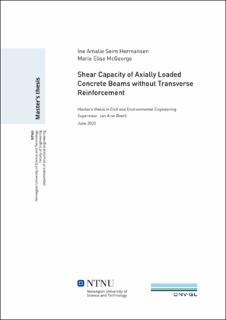| dc.contributor.advisor | Øverli, Jan Arve | |
| dc.contributor.advisor | Mayorca, Paola | |
| dc.contributor.author | Hermansen, Ine Amalie Seim | |
| dc.contributor.author | McGeorge, Marie Elise | |
| dc.date.accessioned | 2021-09-21T16:11:21Z | |
| dc.date.available | 2021-09-21T16:11:21Z | |
| dc.date.issued | 2020 | |
| dc.identifier | no.ntnu:inspera:56731605:24431832 | |
| dc.identifier.uri | https://hdl.handle.net/11250/2780015 | |
| dc.description.abstract | Betongbjelker blir ofte brukt som lastbærende elementer i blant annet bygninger, broer og i offshorekonstruksjoner, hvor de utsettes for forskjellige lastvirkninger. Kapasiteten til bjelkene avhenger både av størrelsen på hver lastvirkning, og på hvordan lastene kombineres. Aksielle trykkspenninger, forårsaket av forspent armering eller ytre laster, vil øke skjærkapasiteten til konstruksjonsdeler i betong. Ettersom dagens standarder i hovedsak baserer seg på empiriske modeller for skjærberegning i konstruksjonsdeler uten skjærarmering, er det likevel noe usikkerhet knyttet til hvordan skjærkapasiteten vil påvirkes ved stor aksialkraft.
Denne artikkelen ser på skjærkapasiteten og den mekaniske oppførselen til betongbjelker uten skjærarmering som er utsatt for aksiell trykklast. Ni skjærkritiske bjelker ble utsatt for en firepunkts-test til brudd. Bjelkene ble delt inn i tre sett før testene startet. Det første settet var et referansesett, og disse bjelkene ble testet uten aksiallast. Bjelkene fra det andre settet ble påført en aksialkraft på 500 kN, og bjelkene fra det tredje settet ble påført en aksialkraft på 800 kN. Alle bjelkene gikk til skjærbrudd under testingen. Bjelkene uten aksialkraft fikk diagonalt strekkbrudd, mens bjelkene med aksialkraft fikk skjær-trykkbrudd. Resultatene fra testingen viste at skjærkapasiteten økte med aksiallasten, og at forholdet mellom disse størrelse kunne beskrives som lineært.
For å kontrollere nøyaktigheten av empiriske formelverk ved stor aksiallast, ble resultatene sammenlignet med utregnede skjærkapasiteter fra standardene Eurokode NS-EN 1992-1-1:2004+A1:2014 +NA:2018 (Eurokode 2) og DNVGL-ST-C502. De utregnede verdiene baserte seg på middelfastheten i betongbjelkene, uten sikkerhets- og materialfaktorer. Resultatene fra DNVGL-ST-C502 traff da bedre for bjelkene med aksiallast, og Eurokode 2 ga et mer nøyatig resultat for bjelkene uten. Mens det virker som at Eurokodens formler for skjærkapasitet overvurderer effekten av aksiallast på skjærkapasiteten, hadde aksiallasten en mer begrenset innvirkning på den utregnede kapasiteten fra DNVGL-ST-C502. | |
| dc.description.abstract | Concrete beams are common load-bearing members in structures such as buildings, bridges and offshore structures, where they are exposed to different types of load. Their capacity to resist these loads depends, not only on the magnitude of the loads, but also on how the loads are combined. Compression stress, caused by either applied axial forces or by prestressed reinforcement, is known to increase the shear capacity of a concrete specimen. However, as the standards used today are often based on empirical models when calculating shear in members without transverse reinforcement, there are some uncertainties as to how the shear capacity is affected when the axial load reaches larger magnitudes.
This paper investigates the shear capacity and mechanical behaviour of concrete beams without shear reinforcement, subjected to large axial loading. Nine shear-critical concrete beams were subjected to a four-point test until failure. The beams were divided into three sets prior to testing. The first set was considered as a reference set, and these beams were tested without any axial load. An axial load of 500 kN was applied to the beams in the second set, and an axial load of 800 kN was applied to the beams in the third set.
All the beams reached shear failure during the four-point test, where the beams without any axial load reached inclined tension failure and the beams with axial load reached shear compression failure. The testing showed that the shear capacity of the beams increased with the magnitude of applied axial load, and a linear relationship was observed between the load and the capacity.
The results were compared to calculated shear capacities from the standards Eurocode NS-EN 1992-1-1:2004+A1:2014 +NA:2018 (Eurocode 2) and DNVGL-ST-C502, in order to see if the empirically based equations in these standards would be accurate for beams with large axial loads. When using the average concrete strength and omitting all safety and material factors from the equations, the calculated values from DNVGL-ST-C502 gave a better estimation for the test beams with high axial loading, and Eurocode 2 gave more accurate calculations for the beams without any axial load. While the Eurocode 2 seems to overestimate the effect of compressive stress on the shear capacity, axial loading seems to have a more limited impact on the calculated shear capacity from DNVGL-ST-C502. | |
| dc.language | | |
| dc.publisher | NTNU | |
| dc.title | Shear Capacity of Axially Loaded Concrete Beams without Transverse Reinforcement | |
| dc.type | Master thesis | |
